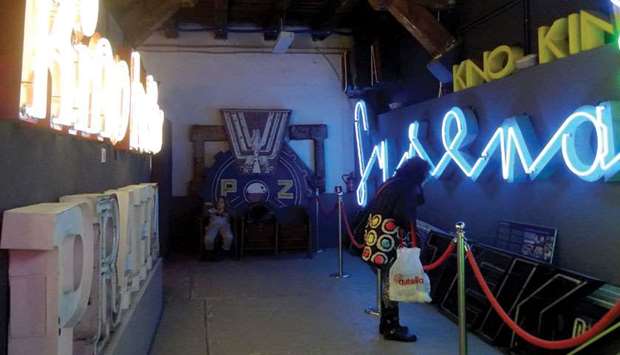It all began with a sign that simply read “Berlin.” Ilona Karwinska found the communist-era neon advertising board in a Warsaw shop that used to sell Western clothing.
The sign, with its curling tubes full of bright red gas, was the first of hundreds she has salvaged. It now hangs between other ads from the 1950s to 1970s in Europe’s only neon museum, opened in 2005 and located in the capital’s Praga district.
At the beginning, Karwinska used her balcony to store the bulky signs from train stations, restaurants and businesses, replete with artful scripts and even animal motifs, says her colleague Izabela Michalska.
Today, the museum in the Soho Factory, a former industrial site that now serves as a giant workshop for the city’s creatives, is bursting at the seams. Attracting some 400 visitors a day, the museum still has 200 signs in storage.
About 50 prime examples glow on the old factory’s dark walls. The favourite piece among visitors is a neon incarnation of the Warsaw coat of arms, complete with the “Syrenka” mermaid. “Our Instagram star,” says Michalska.
While visually enticing, the exhibits also offer a fascinating snapshot of Polish history.
Illuminated advertising came into fashion after the 1953 death of Soviet leader Joseph Stalin. Poland’s next communist government was less repressive and chose to take on the West at its own game: With hefty state funding channelled to artists and manufacturers, Western neon advertising was co-opted to beautify dark communist buildings.
“It was supposed to be better than capitalist advertising in the West,” says Michalska. “This was intended to produce works of art.”
Hundreds of neon advertisements lit up Warsaw’s main streets, Aleje Jerozolimskie and Ulica Pulawska. Some originals, like the sign of an instrument shop, still shine there today.
Other Polish cities also boasted their own distinctive neon culture. Katowice in southern Poland was a riot of colour, earning the nickname “little Vegas.” Even small villages had their own neon ads, so far did the fad grow.
Neon was popular in other Soviet Bloc countries too, but it peaked in Poland, reaching staggering production volumes.
“About 380 million kilometres of fluorescent tubes were made from 1950 to 1960,” says Michalska. “About the distance from the earth to the moon.”
An interesting subplot of the story behind Poland’s neon romance is that the medium was actively promoted by the state, offering more artistic freedom than even literature, which was strictly censored.
To illustrate the point, Michalska points to a Warsaw restaurant sign that used to stand near the US Embassy. The inscription “ambasador” is in the style of a western saloon and would have been banned in other Soviet Bloc states, she notes.
The neon boom fell into decline after the 1970s. Damaged signs were thrown in the trash, while others simply consumed too much electricity for their owners to keep them. In Poland, the medium was also eventually supplanted by advertising from the West after the fall of the Iron Curtain in 1989.
Today, the neon ad is a testimony to Polish art, say the museum staff, who run a flourishing nationwide rescue service for endangered illuminated signs.
Using the museum’s takings and some external funding, the Warsaw neon sign devotees can restore almost any old signs to life, but at a cost of thousands of euros each. In Katowice and Wroclaw, there are also some private initiatives to save old neon tube ads.
Only the Warsaw museum completely reconstructs broken signs. In doing so, it must often refer to the old design sketches kept at the Warsaw Museum of Modern Art.
In an ironic twist in the neon sign story, the industry is in fact growing again. Demand for old Polish designs is rising, especially among local firms looking to tap the retro market, and tourists seeking unique souvenirs with stylish lettering and motifs of yesteryear. – DPA

ON DISPLAY: The Neon Museum in Warsaw features more than 50 examples of neon signs from Poland’s communist era.


